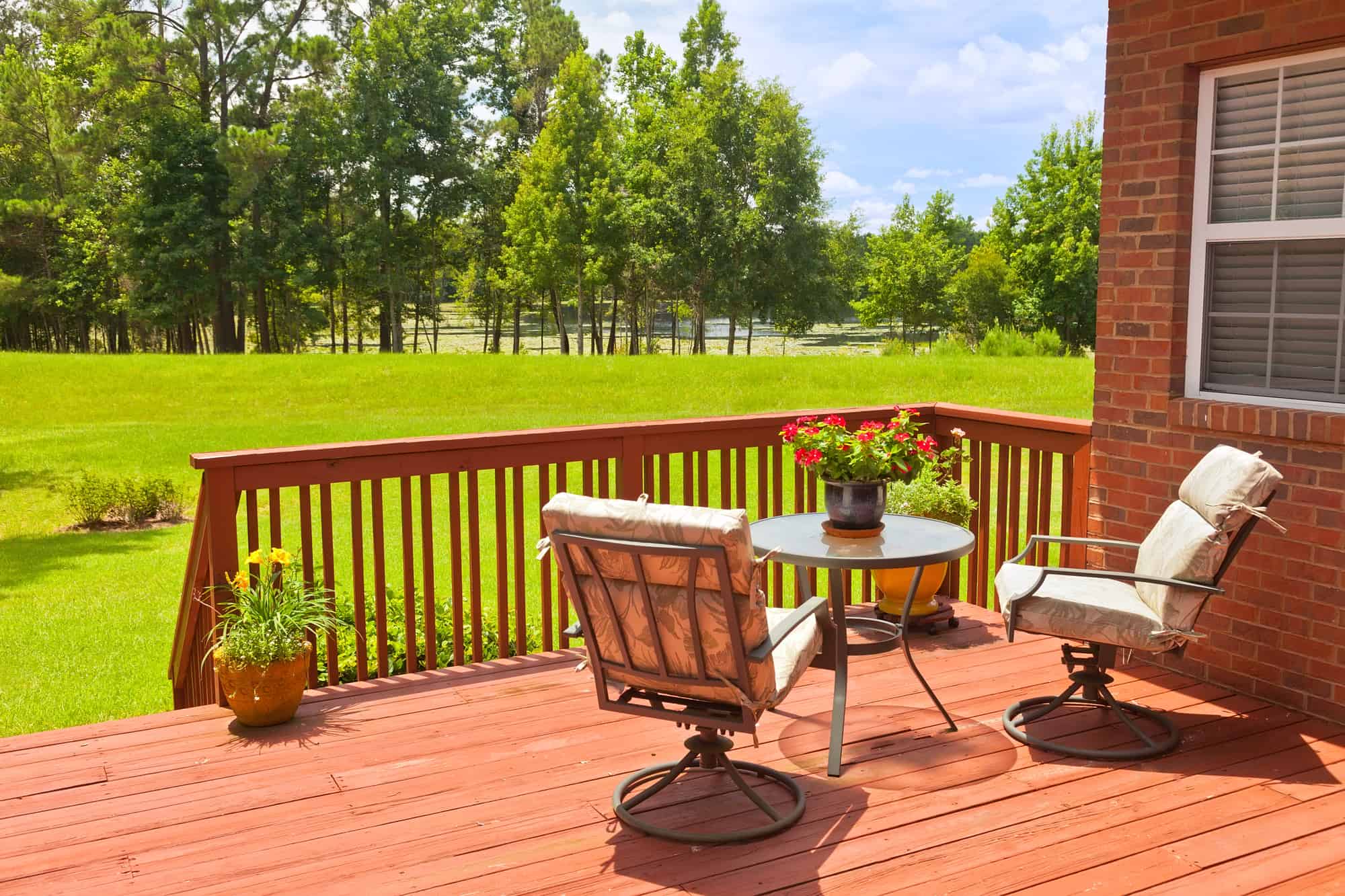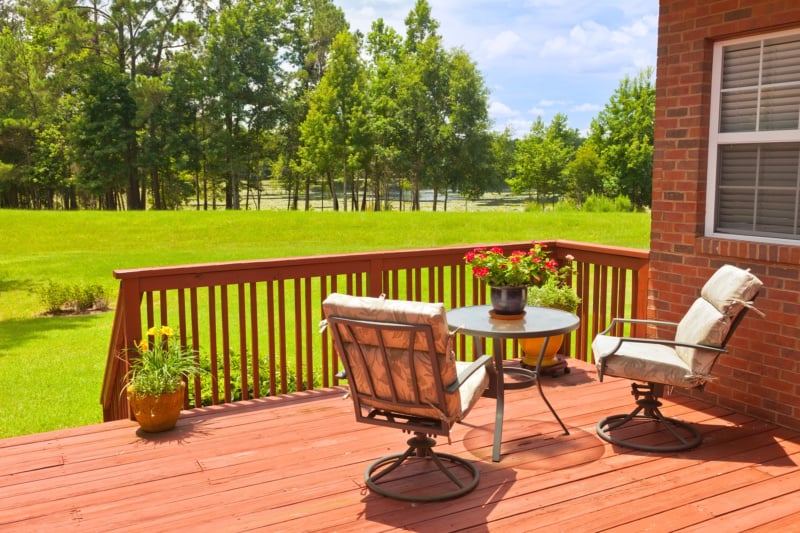
What Is the Best Decking Material?
So, you’ve decided that you want to build a deck for your home or business. What type of wood should you use? Should you even use wood, or are composite and plastic materials better?
The truth is, there is no universal “best” decking material. However, there is one that is best for you. Unique factors such as your location, your budget, and the type of deck you’re looking to build will ultimately determine which material you should choose.
To make this important decision, it’s important to know the strengths and weaknesses of each option. In this guide, we’ll go over the pros and cons of every decking material, from softwoods to capped PVC, as well as what situations would make them the best material for the job.

Softwoods
Softwood is a type of lumber that comes from conifer trees. The most commonly used is pine, but you may also see decks made from spruce, cedar, or redwood. By far, the greatest advantage of softwoods is their low cost. Because they’re lighter than hardwood, they are also easier to work with and install.
The downside is that softwoods tend not to last as long as other options. Pressure-treated softwood lasts longer than untreated wood, but it still requires routine maintenance to maintain its appearance.
Pros:
- Most affordable option
- Easy to work with and install
- Natural appearance
Cons:
- Least durable option
- Requires careful maintenance
Softwood may be the best decking material for you if affordability is high up on your list of priorities and you don’t mind the extra maintenance.
Hardwoods
Hardwood is any lumber that comes from broadleaved trees. Examples of hardwoods commonly used in decking projects include Ipe, cumuru (Brazilian teak), and teak.
Compared to softwoods, hardwoods offer greater durability and lower maintenance. Because they’re so dense, they’re also naturally resistant to moisture and insects. While hardwood decking is more expensive upfront, it won’t need to be replaced as quickly or treated as often, saving you money in the long run.
While hardwoods require less maintenance than softwoods, that does not mean they are maintenance-free. To prevent exterior hardwoods from greying over time, you’ll need to protect your deck UV exposure by restaining or oiling it every 2 or 3 years.
Pros:
- Durable
- Long-lasting
- Natural appearance
- Moisture-resistant
- Insect-resistant
- Reduced maintenance compared to softwoods
Cons:
- More expensive than softwoods
- Difficult to work with due to weight
Hardwood is the best decking material for you if you want something more durable and easier to take care of than softwoods, but don’t want to give up the appearance of natural wood.
Capped Composite
Composite decking is made from a combination of natural wood pulp and artificial plastics. While we tend to think of plastic as something that is harmful to the environment, composite decking is actually more environmentally friendly than 100% wood decking because it can be made from recycled materials. Two of the most popular recycled composite decking brands are Trex and TimberTech.
“Capped” decking is surrounded by a hard plastic shell, making it more durable and less prone to fading and staining than uncapped composite. If aesthetics are important to you, the resin cap can also be customized to mimic the appearance and texture of natural hardwoods.
Pros:
- Durable
- Long-lasting
- Low maintenance
- Insect-resistant
- Moisture-resistant
- More cost-effective than PVC
- Easy to customize
Cons:
- More expensive than wood
- Absorbs more heat than wood
Capped Composite is the best decking material for you if you are looking for something more cost-effective than PVC but stronger and more durable than wood, capped composite decking is a perfect compromise.
Capped PVC
Like capped composite, capped PVC adds an extra layer of protection to a standard plastic deck. Capped PVC is so tough that brands like Azek even promise a lifetime warranty against rot and termites.
But just because it’s the most durable decking option available does not mean that capped PVC is the best decking material for you. Because it costs more than wood and composite decking, it’s safe to say capped PVC won’t fit into every construction budget.
Pros:
- Durable
- Long-lasting
- Low maintenance
- Fade and stain-resistant
- Scratch-resistant
- Moisture-resistant
- Insect-resistant
- Easy to customize
Cons:
- Most expensive option
- Absorbs more heat than composite
Capped PVC is the best decking material for you if you want a deck that truly stands the test of time, and you don’t mind paying a bit extra for it.
Composite
Much like capped composite, composite decking is durable and easy to work with. Because it’s not capped, monolithic composite is not as well-protected from the elements, but it is more cost-effective. The lack of a resin cap also makes composite decking look more like natural wood. EverGrain and MoistureShield are examples of reputable composite brands.
Compared to PVC, composite decking is better able to withstand extreme climates — it won’t expand and contract as much in high temperatures. So if you live in a somewhat unpredictable climate, composite decking might be able to offer you better stability.
Pros:
- Durable
- Long-lasting
- Low maintenance
- Easy to work with
- Moisture-resistant
- Insect-resistant
- Greater stability in extreme climates
- Cost-effective
- Natural appearance
Cons:
- Less scratch-resistant than PVC
- More expensive than wood
Composite is the best decking material for you if you want to build a complex project near water (poolside or seaside) and want the natural texture and appearance of wood without the extra maintenance.
Plastic (PVC)
Like composite, plastic decking is simply a more cost-effective alternative to capped PVC. It is highly fade-resistant, keeping its original color for many years with very little maintenance. It’s also stain resistant, making it a great choice for high-traffic areas. Brands like WearDeck and LumbeRock specialize in manufacturing PVC decking made from recycled materials.
While PVC has the best weather resistance of any material, plastic does not fare as well in the heat. In climates where temperatures fluctuate often, plastic decking can expand and contract, causing the deck to become less stable over time. And in direct sunlight, plastic can heat up very quickly, making your deck an unwelcoming place for bare feet.
Pros:
- Durable
- Long-lasting
- Low maintenance
- Fade and stain-resistant
- Weather-resistant
- Insect-resistant
- Easy to clean
- Made from recycled materials
Cons:
- Absorbs more heat than other materials
- Synthetic appearance
- More expensive than composite
Plastic (PVC) is the best decking material for you if…you don’t want to worry about maintenance, expect a lot of activity on your deck, and live in a mild climate.
Find All of the Materials You Need at Decks & Docks
So to wrap up, there is no right answer to the question, “What is the best decking material?” To build the perfect deck, you’ll need to think carefully about what your goals are in order to choose a material that meets those needs.
The quality of your finished deck will also depend on where you get your materials. When you get your decking materials from a Decks & Docks lumber yard, you never have to worry about buying low-grade wood, composite, or PVC. We only work with trusted brands like Trex and Azek that produce premium, marine-grade material. To learn more about the different types of decking, check out our comparison chart or give us a call.
- About the Author
- Latest Posts
Dan has worked for Decks and Docks for over twenty-five years. He managed the original Decks and Docks store in St. Pete, which is our largest store. Dan is simply the best all around. He knows more about this company and our products than probably anyone else. Dan currently works in Sales at our corporate office.
